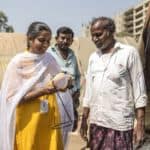Overcoming the Challenges in Mobile: Living Goods hopes to follow in the footsteps of Amway, Avon, and Tupperware
In a dark, poorly lit bar located off a nearly impassible rutted track of dirt rented out for this monthly occasion sits a group of impressively vibrant women. Their bright white and blue aprons provided by Living Goods proclaim: “Better health. Better incomes. Better lives.”
It’s not the setting that comes to mind when you think of mobile innovation. But this is where Living Goods agents are being trained to use their mobile phone to drive the organization’s impact, sustainability, and scale.
As Armando Huerta, Living Goods’ East Africa Business Officer said to me, “Think of teaching your grandmother to use our SMS program when she’d never sent a message before in her life. Then think of asking her to do that to record hundreds of interactions every month.” This is no small switch.
With a core business in health care sales, Living Goods is no stranger to behavior change. Despite the challenges to rolling out a new mobile system to a sales force of 250 women, most over 40 years old, 60 percent of who had never used SMS before, the organization is seeing some early successes.
To see firsthand how the company was overcoming the above challenges, I left the Living Goods office to join in-person trainings and spend the afternoon observing Community Health Promoters (CHPs) interacting with their clients. There, the organization demonstrated how a focus on energizing in-person training sessions, incentive programs, and constant iteration brings the platform to life. Their unwavering commitment to intuitive, simple processes provides solid evidence of why uptake continues to grow.
Training for success
Amway, Avon, and Tupperware teams are hosting nearly identical meetings with sales reps around the world. And they’re making a lot of money from the results. Living Goods wants nothing less than to follow in their footsteps with the added goal of improving the health, wealth, and productivity of their customers in the process. This does not feel like a charity: this is a business with a purpose.
Michael Rusoke,, Living Goods’ Health training officer is an expert facilitator with experience in HIV/AIDS education and three years working with Living Goods. He starts the meeting off on a high note. President Bill Clinton and Secretary of State Hillary Clinton had visited Uganda earlier in the week. This visit was a point of pride for many Ugandans. Rusoke reminds the attendees that while in Kampala, President Clinton asked Living Goods to join the Clinton Foundation’s fight to tackle child deaths from diarrhea – the training attendees are beaming. Betty Kyazike, a top performer in the organization and leader of the Tula branch office then launches into monthly targets and progress towards commitments and organizational goals.
At the top of her list: progress on SMS reporting.
Attendees go through an exercise outlining difficulties with using the platform. Semakula, an older CHP in the audience sums up the sentiments of the group members who are performing below expectations with SMS reporting: “I just do not have confidence with the program,” she states.
Armando and the Living Goods team know that after launching a product or process an organization has a limited window to reach the tipping point in uptake. If the platform malfunctions, if CHPs don’t see the value of participation, it will fail. Building Semakula’s confidence can make or break the system.
A trainer/learner exercise then pairs those who are excelling with the new platform with the laggards for a series of practice cases and reporting exercises using real-world examples. After these exercises, all trainers report difficulties the “learners” experienced for a read-out to be presented to Armando and the platform developer immediately after the meeting. Semakula was paired with Faridha, who is proud to be among the more tech-savvy CHPs. Before the exercise concludes, Semakula is standing in front of the audience demonstrating proper entry of pregnancy information for an expecting mother.
Incentives
After a demonstration on sales techniques for a new line of solar products, the session comes to a close with an awards presentation for the CHPs with the highest SMS platform use over the past month in this locality. The top 15 performers receive cash prizes and energetic praise from their colleagues. Gertrude, a CHP attendee, recently won a raffle (entries were done through SMS reporting) that landed her with a brand new phone. The other attendees know this and readily admit to being just a bit jealous.
Gertrude is one of the best sales agents in this district. Nowadays, she attributes some of her continued success with these clients to her improved ability to coordinate reminders using SMS. She logs all treatments and patient visits for new pregnancies or births, malaria, diarrhea, and pneumonia on the platform. For Gertrude, the ability to improve client satisfaction means a higher income and more lives saved. The day before, I watched Gertrude complete nearly one sale every 10 minutes – everything from fungicide to amoxicillin and malaria ACTs – going door-to-door in her neighborhood on the outskirts of town.
Constant iteration
Back at the headquarters office, Armando Huerta, Living Goods’ East Africa business officer, pores over the feedback for each monthly training meeting. Some learnings will translate into next month’s training, others will be passed on to the platform developers. Huerta is quick to note that the platform is under constant iteration as he tells me, “we test, test, test, revamp, and then test some more.” ‘Do, learn, fix’ is Living Goods guiding philosophy.
Beyond the field work described above to increase CHP adoption, Armando’s team has worked patiently to negotiate discount contracts with Uganda’s major mobile providers for the hundreds of thousands of SMS messages the organization sends each month. Finding a developer who could build a simple but nimble platform at the right cost took time. Yet few processes in Eastern Africa are quick and easy.
Living Goods still faces challenges in the form of network outages, phone charging and power issues, and model-specific handset compatibility. In the coming months they will test new programs to discount solar powered chargers and phones for CHPs that may successfully address some of these issues.
The organization humbly recognizes that they haven’t figured out every kink just yet. But their results to date suggest that they’ll continue to overcome issues as they arise. And of course, we’ll look forward to providing you updates on their progress here on NextBillion.
Editor’s Note: This article was voted by readers as one of NextBillion’s Most Influential Articles of 2012.
Josh Cleveland is a Marketing Manager at Unilever leading projects that build the company’s social impact with lower-income consumers in developing markets.
Photo courtesy of DFID.
- Categories
- Health Care, Technology



